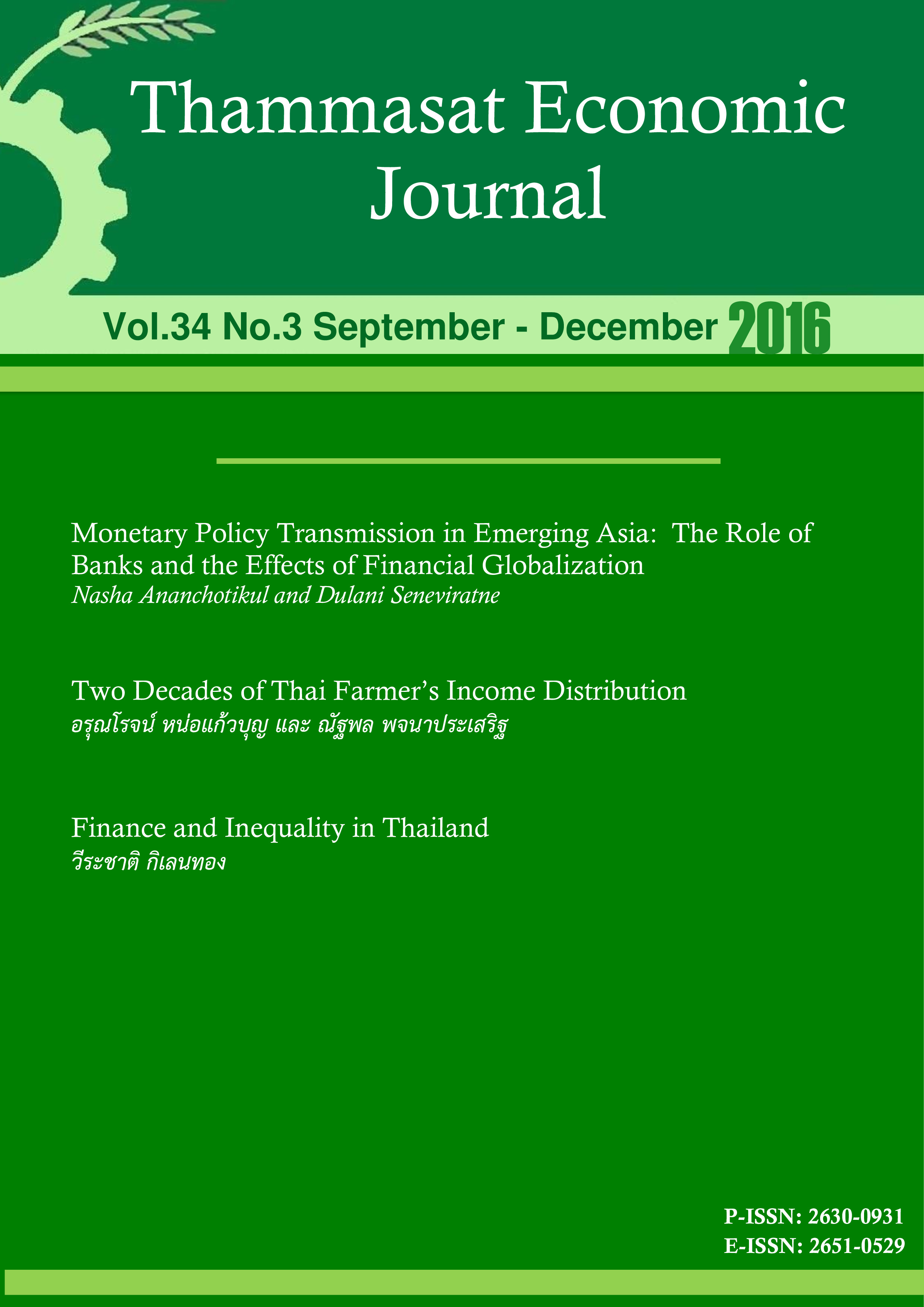Two Decades of Thai Farmer’s Income Distribution
Keywords:
Income Distribution, Thai rice farmers and Agriculture’s economic growthAbstract
The income distribution of Thai farmers over the last two decades represents an interesting case study. This study employs the concept of “Pro-Poor Growth” using secondary data collected by the Office of Agricultural Economics in the periods 1995/96 and 2012/13. The results revealed that over this period the income of farmers as a whole rose. However, despite such growth income inequality among farmers worsened, with the exception of farmers in the irrigation area, small cultivated areas and central region. The agricultural economic growth experienced failed to provide tangible benefits to poor farmers at all. Rich farmers alone were able to take advantage. To ameliorate this problem, the government should invest in improving the infrastructure, especially irrigation systems, centralizing markets and educating farmers to maximize both their bargaining power and productivity.
References
ชีวิน สันธิ. (2556). ความสัมพันธ์ระหว่างการเติบโตและความไม่เท่าเทียมทางรายได้: ผลกระทบของการเคลื่อนย้ายแรงงานระหว่างภาคการผลิต กรณีศึกษาประเทศไทย. วิทยานิพนธ์เศรษฐศาสตรมหาบัญฑิต, มหาวิทยาลัยธรรมศาสตร์, สาขาเศรษฐศาสตร์.
ธเนศ กองประเสริฐ. (2551). ไทยกับวิกฤตแฮมเบอร์เกอร์. (Online) https://www.thaiworld.org/th/thailand_monitor/answer.php?question_id=814
สวรัย บุณยมานนท์. (2550). ปฏิสัมพันธ์ระหว่างการกระจายรายได้และการเจริญเติบโตทางเศรษฐกิจ: หลักฐานเชิงประจักษ์จากข้อมูลระหว่างประเทศและไทย. วิทยานิพนธ์เศรษฐศาสตรดุษฎีบัณฑิต จุฬาลงกรณ์มหาวิทยาลัย, สาขาวิชาเศรษฐศาสตร์.
สำนักงานเศรษฐกิจการเกษตร. (2557). ค่าสัมประสิทธิ์จีนีภาคเกษตร จำแนกตามระดับภาค/ประเทศ ปีเพาะปลูก 2538/39-2554/55. สืบค้นจาก https://infoservice.oae.go.th/index.php/households-m/125-c-jini-art
_______. (2548). การเปลี่ยนแปลงการกระจายรายได้และทรัพย์สินของครัวเรือนเกษตร. เอกสารการวิจัย เลขที่ 115 .
สำนักงานสถิติแห่งชาติ. (2536-2556). สถิติประชากรภาคเกษตรของประเทศไทย. หนังสือการสำรวจสภาวะการทำงานของประชากรจำแนกตามอุตสาหกรรม, ห้องสมุดสำนักงานสถิติแห่งชาติ, ศูนย์ราชการเฉลิมพระเกียรติ ๘๐ พรรษา อาคารรัฐประศาสนภักดี ชั้น 2.
สำนักงานคณะกรรมการพัฒนาการเศรษฐกิจและสังคมแห่งชาติ. (2536-2556). สถิติมูลค่าผลิตภัณฑ์มวลรวมประชาชาติเฉพาะภาคเกษตร.(Online). https://www.nesdb.go.th/Default.aspx?tabid=96
_______. (2557). ตัวชี้วัดความยากจนและการกระจายรายได้ ทั่วราชอาณาจักร. สืบค้นจาก https://social.nesdb.go.th/social/Default.aspx?tabid=131
เสาวณี จันทะพงษ์ และ ดวงทิพย์ ศิริกาญจนารักษ์. (2555). เจาะลึกการจัดการข้าวไทยในมิติการกระจาย รายได้และประสิทธิภาพการผลิต. ม.ป.ท., ฝ่ายวิจัยเศรษฐกิจ ธนาคารแห่งประเทศไทย.
สุพัตรา แตงเอี่ยม. (2544). การเปรียบเทียบการกระจายรายได้และภาวะความยากจนของครัวเรือน เกษตรไทย. วิทยานิพนธ์วิทยาศาสตรมหาบัณฑิต, มหาวิทยาลัยเกษตรศาสตร์, สาขาเศรษฐศาสตร์เกษตร.
อรวรรณ ศรีโสมพันธ์. (2557). โครงสร้างการผลิตและการตลาดข้าวหอมมะลิไทย. กรุงเทพมหานคร: กองทุนสนับสนุนการวิจัย (สกว.) และสถาบันคลังสมองของชาติ.
อานันท์ชนก สกนธวัฒน์. (2555). พลวัตของความยากจน กรณีศึกษาครัวเรือนชาวนาในพื้นที่เขตชนบท ภาคตะวันออกเฉียงเหนือและภาคกลางของไทย. กรุงเทพมหานคร: กองทุนสนับสนุนการวิจัย (สกว.) และสถาบันคลังสมองของชาติ.
Amir, R. and Dan, S. (2015). The effects of economic growth on income inequality in the US. Journal of Macroeconomics, 45 (2015), 258–273.
Bashir, O. K.; A. O. Olufunsho, and O. Y. Jameelah. (2015). Poverty, Inequality and Rising Growth in Nigeria: Further Empirical Evidence.International Journal of Economics and Finance, Vol. 7, No. 2; 2015.
Chang, J. Y. and Ram, R. (2000). “Level of Development, Rate of Economic Growth and Income Inequality”. Economic Development and Cultural Change 48 (4): 787-799.
Deaton, A. (1989). Rice Price and Income Distribution in Thailand: A Non-parametric Analysis. The Economic Journal, 99 (395), 1-37.
Dierk, H. and Peter, N. (2015). “Income Inequality and Health: Evidence from Developed and Developing Countries.” Economics: The Open-Access, Open-Assessment E-Journal Vol. 9, 2015-4.
Dollar, D. and Kraay, A. (2002). Growth is Good for the Poor.Policy Research Working Paper 2587, World Bank, Washington, DC.
Fernando, D., D. Carlos, and Maria, A. C. (2014). Income Inequality and Economic Growth: New Evidence From Latin America. Cuadernos de Economía, 33(63), 381-398.
Kuznets, S. (1995). Economic Growth and Income Inequality.The American Economic Review.
Lee. E. and Vivarelli, M. (2006). The social impact of globalization in the developing countries. International Labour Review, Vol. 145 (2006), No. 3.
Loesse, J. E. (2012). Is Economic Growth In Cote D'Ivoire Pro-Poor. Evidence Form LSMS Data: Anote. Bulletin of Economic Research, 64:4, 2012, 0307-3378.
Mehmet, M. and Ozlem, A. A. (2013). The Relationship Between Economic Growth And Income Distribution In Turkey And The Turkish Republics Of Enntral Asia And Caucasia: Dynamic Panel Data Analysis With SrructuralBraeks. Eurasian Economic Review, 3(2), 2013, 165-182.
Ravallion, M. and Chen, S. (2003). Measuring Pro-Poor Growth. Economics Letters, 78(1), 93-99.
Ravallion, M. (2004).Pro-poor Growth: A Primer. Development Research Group, World Bank 1818 H Street NW, Washington DC.
Ravissa, S. (2011). Evaluation of Food Security Policy and Other Alternatives under Market Power Concept: Thai Rice Production. Funded by the Thai Research Fund
Samuel A. Morley (2000). The effects of growth and economic reform on income distribution in Latin America. CEPAL Review, 71, 23-40
UNDP. (2004). Pro-poor Growth: Concepts and Measurement with Country Case Studies. Working paper Number1.
Vos, R.,E. Ganuza, S. Morley, and Robinson, S. (2006). Who Gains from Free Trade: Export-led Growth, Inequality and Poverty in Latin America. Abingdon.
Ying, W. and Hong, Y. (2015). Income Inequality, State Ownership, and the Pattern of Economic Growth – A Tale of the Kuznets Curve for China since 1978.Atl Econ J (2015) 43, 165–180.
Zouheir, A. and Mohamed, S. (2012). Economic Growth and Income Inequality: Empirical Evidence from North African Countries. Zagreb International Review of Economics & Business, Vol. 15, No. 2, pp. 29-44.










